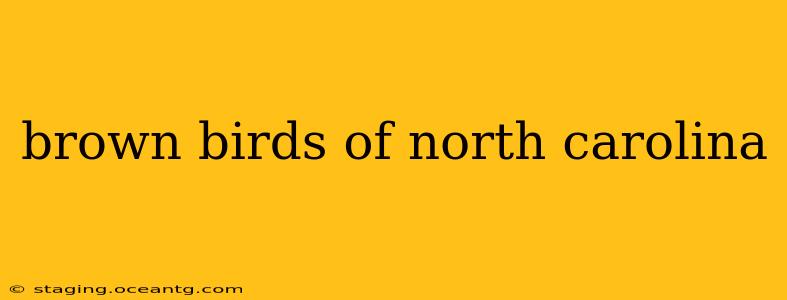North Carolina boasts a rich avian diversity, and many of its feathered residents sport beautiful shades of brown. Identifying these birds can be challenging, as brown is a common plumage color, varying in intensity and shade. This guide will help you navigate the world of brown birds found in the Tar Heel State, providing detailed descriptions and identifying features to aid in your birdwatching adventures.
What are some common brown birds in North Carolina?
This is a broad question, as many bird species in North Carolina exhibit brown plumage in some part of their feathers. Some of the most common and easily recognizable brown birds include:
- Northern Cardinal (male): While the striking red of the male Northern Cardinal is iconic, young males and females exhibit a predominantly brown plumage, often with reddish tinges. They're readily identifiable by their crested head and distinctive conical bill.
- Brown Thrasher: This large, striking bird is unmistakable with its long tail, reddish-brown upperparts, and heavily streaked underparts. Their loud, complex songs are also a key identifier.
- Eastern Towhee: These birds are easily spotted by their characteristic "drink-your-tea" call. They feature a rich brown back, rufous sides, and a distinctive white belly.
- Field Sparrow: A small, unassuming sparrow, the Field Sparrow displays a warm brown back, streaked breast, and a pink bill. They're often found in fields and open areas.
- House Wren: These tiny birds are active and energetic, flitting about in gardens and woodlands. They have a rich brown back, lighter underparts, and a long, slightly decurved bill.
- Wood Thrush: Though displaying some brown tones, their distinctive spotted breast and melodious songs make them easily identifiable.
What are some less common brown birds in North Carolina?
Beyond the more common species, several less frequently sighted birds also feature brown in their plumage. These often require a closer look or a keen eye for detail. Some examples include:
- Short-eared Owl: While primarily nocturnal, these owls show a striking brown and buff coloration, blending perfectly with their habitat.
- Whip-poor-will: This elusive nightjar is mainly brown and mottled, camouflaged expertly amongst the forest floor.
- Loggerhead Shrike: This predatory bird is brown above and whitish below, with a distinctive black mask across its eyes.
How can I identify brown birds in North Carolina?
Identifying brown birds often requires more than just noting their color. Pay close attention to the following:
- Size and Shape: Compare the bird's size and overall shape to known species. Are its wings long and pointed? Is its tail long or short?
- Streaking and Markings: Examine the pattern of streaks, spots, or other markings on the bird's breast, back, and wings.
- Bill Shape and Color: The shape and color of a bird's bill can be a valuable clue.
- Habitat: Where did you see the bird? Different birds inhabit specific habitats.
- Behavior: Observe the bird's behavior. Is it foraging on the ground? Is it hopping or flitting?
- Sounds: Listen carefully to the bird's calls and songs. Many species have distinct vocalizations.
What resources are available to help me identify brown birds in North Carolina?
Numerous resources can assist in your bird identification endeavors:
- Field Guides: A good field guide specific to North Carolina or the southeastern United States is invaluable.
- Online Resources: Websites like the Cornell Lab of Ornithology's All About Birds and eBird offer excellent resources, including photos, sounds, and range maps.
- Local Audubon Societies: Joining a local Audubon chapter provides opportunities for guided bird walks and expert advice.
What is the best time of year to see brown birds in North Carolina?
While many brown birds are year-round residents, migration seasons (spring and fall) often bring an influx of additional species, increasing your chances of sighting a wider variety.
By utilizing a combination of these strategies and resources, you'll be well-equipped to identify the diverse array of brown birds that call North Carolina home. Happy birding!
